Plaubel Makina
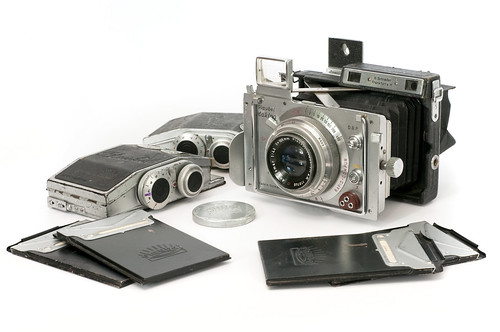
|
| Makina IIIR with roll and sheet-film holders image by Sally Turner (Image rights) |
The Makina is a long-lived strut folding camera made by the German company Plaubel from around 1911 to around 1960; for the model made in the 1970s and 1980s by the same company after it became Japanese, see Makina 67.
Contents
The 6x4.5cm viewfinder model
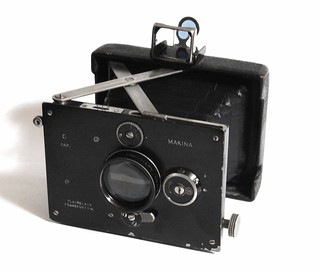
|
| with Anticomar 1:3 7.5cm lens image by yalluflex (Image rights) |
The original Makina model (sometimes called Baby Makina by today's collectors) was launched in 1911 or 1912 and is a strut folding press-type camera, taking 6x4.5cm film plates. The big rectangular front plate hosts the lens, a Plaubel Anticomar - with a focal length of 7.5cm and available with f/4.2, f/3 or f/2.8 as maximum aperture, mounted on a central Compur dial-set shutter. The diaphragm selector is on the side of this front plate, while the focusing is achieved by means of a small wheel on the other side of the front plate, as for all later Makinas.
Small variations are reported to exist in the viewfinder type:
- folding, simple one-lens, on the back
- folding, special two-lens, on the back
- folding, off-centre, one lens on the front plate and the eyepiece on the rear; and also folding frame finder (like later Makinas)
The camera was concurrence to other strut folding baby cameras of the time, like the Goerz Tenax or the Gaumont Block-Notes, but it had more descendants.
  
|
| Plaubel Makina 4x6.5cm (Baby Makina), Anticomar f3/7.5cm Lens, Compur shutter. Images by yalluflex. (Image rights) |
The 6.5×9 viewfinder models
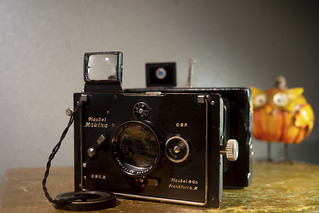
|
| image by Mike Novak (Image rights) |
|
Dial set
The Makina I was introduced in 1920, a strut folding film plate camera with a Compur dial-set leaf shutter with speeds up to 1/200 second, and is in fact very similar to the Baby Makina - except for its size and its capability to take interchangeable lenses
The very first model has a simple folding finder on the rear, and a fixed Plaubel Anticomar lens with a focal length of 10cm, and maximum aperture of f/4.2 or f/3.2.
Later it gained an off-center folding finder, with one lens on the front plate and the eyepiece on the rear, with the addition of a folding frame finder. Later the eyepiece became larger, with a blue-toned glass.
The lens of the later variations is an interchangeable Plaubel Anticomar 10cm f/3.2 or f/2.9 (see "Makina lenses" below).
Rim set
The next milestone in the production of the Makina was the introduction of the Compur rim-set shutter with speeds up to 1/200 second on the Makina I. At about this time, the Anticomar lens was reformulated, switching from 3 to 4 elements.
Production of the viewfinder Makina I was stopped around 1935. All the viewfinder Makinas have the front plate in black finish.
The 6.5×9 viewfinder and rangefinder models
Between-the-lens shutter
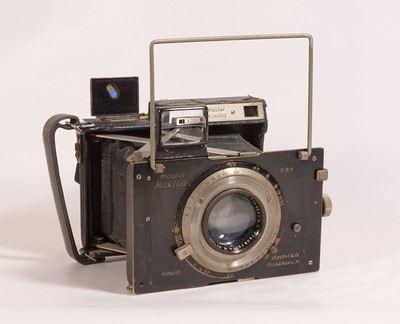
|
| Makina II, black with rangefinder image by willboy2010 (Image rights) |

|
| Makina II, black, viewfinder variant image by Oğuz Ofluoğlu (Image rights) |
The Makina II, introduced as early as 1933, is similar to the rim-set Makina I, some made with the addition of a coupled rangefinder which is separate from the viewfinder. It is the same rangefinder unit that Plaubel would mount on its folding Roll-Op II camera. A manual parallax corrector for the eyepiece was available as an option. This camera can take all the lenses available for the Makina I.
At some point, the diaphragm selector was moved from the side of the front plate to a new location around the lens, where would remain for the next models.
At some moment during the production run, but after the relocation of the diaphragm selector, the finish of the Makina II's front plate switched from black to chrome.
Behind-the-lens shutter
In 1936, the Makina IIS[1] was introduced to replace the Makina II, fitted with a behind-the-lens Compur shutter to 1/200 second.
Although externally the camera does not present big differences, one functional enhancement was also introduced with the Makina IIS: a new range of interchangeable lenses. The previous lenses have to be installed in two parts, one in front of the shutter and the other at the rear. This was quite inconvenient - not to mention its effects if calibration was not absolutely precise-, and the new model has lenses interchangeable as single units.
One can tell a Makina IIS from a Makina II by the bulkier lens, and the two square rangefinder windows (the II has one square and one round window). After World War II, production of the Makina IIS was resumed, with flash synchro for a Plaubel magnesium flash unit, and availability of coated lenses.
In 1949, the Makina III replaced the Makina IIS, with the full flash synchro (electronic and magnesic), a shutter locking button, no self-timer and a holding plate with two tabs attached to the right side of the front plate, where in previous models the diaphragm selector was located.
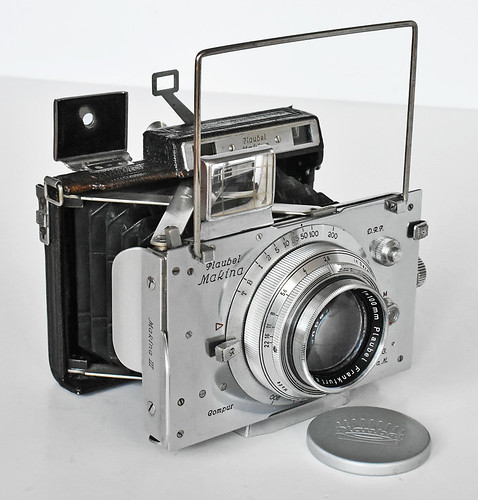
|
| Makina III image by Geoff Harrisson (Image rights) |
1953 saw the introduction of the last German-made version of the Makina, known as the Makina IIIR. The Makina IIIR has a synchro contact on the bottom right corner of the front plate that was also present on late units of the Makina III (maybe production of Makina III and Makina IIIR co-existed) and, most notably, a Compur-Rapid shutter with speeds up to 1/400 second.
Fixed lens
There are two uncommon variants with a rangefinder and a fixed lens, both made just after the war.
The Makina IIa (or Makina 2a as written on the facade) has a between-the-lens Compur-Rapid shutter to 1/400 second, a fixed Plaubel Anticomar 10cm f/4.2 or Schneider Xenar 10cm f/4.5, and a black finish.
The Makina IIb (or Makina 2b) is apparently a simpler version. Its front plate is black with an octagonal chrome motif around the Plaubel Anticomar 10cm f/4.2 lens, a shutter to 1/200 or maybe 1/400 second, and no self-timer.
The stereo models
Two stereo models of the Makina exist: they are very rare.
The Stereo Makina 45×107[2] was launched in 1911 or 1912, at the same time as the original Baby Makina. It makes exposures on 45×107mm plates. It has a shutter to 1/150 second, and two Plaubel Orthar 6cm f/6 or Anticomar 7.5cm f/4.2 or f/3.9. The Newton finder is on the rear part in early examples; then the front lens was moved to the front plate, while the eyepiece is on the rear.
The Stereo Makina 6×13 was launched in 1926.[3][4] It makes exposures on 6×13cm plates. It has the more modern type of viewfinder, with a variation in the eyepiece; at first simple, then enclosed in a square plate in later examples. The shutter is a Compur stereo dial-set shutter, to 1/100 second. The lenses are Plaubel Orthar 9cm f/6 or Anticomar 9cm f/2.9.
Makina lenses
All the Makina interchangeable lenses were made by Plaubel. All have the focal length marked in centimeters, even those made in the 1950s.[5]
RF coupling of Makina lenses
Only the standard lenses (10cm focal length) are fully coupled to the rangefinder.
With the tele lenses the rangefinder virtually acts as an uncoupled RF. To focus, the user should set the struts at the normal position, focus with the rangefinder and then set the given distance on the lens helical.
With the wide angle lens, one can focus with the rangefinder with the bellows extended and struts locked at the normal position, then set the bellows to the first, wide-angle position and then re-focus to the distance previously read; a slow procedure.

|
| 1934 Makina II with Anticomar 10cm f/2.9 lens image by Geoff Harrisson (Image rights) |
Lenses with a between-the-lens shutter
These lenses can be mounted on the Makina I designed for interchangeable lenses, and on the Makina II. All were made by Plaubel. Only the standard lenses (10cm focal length) are coupled to the rangefinder.
- Plaubel Rapid Weitwinkel Orthar (marked Rap. Weitw. Orthar) 7.3cm f/6.8
- Plaubel Anticomar 10cm f/4.2 (from about 1936)
- Plaubel Supracomar 10cm f/3.9
- Plaubel Anticomar 10cm f/3.2 (rare, available with the first Makina I)
- Plaubel Anticomar 10cm f/2.9 (triplet formulation, made until about 1932)
- Plaubel Anticomar 10cm f/2.9 (reformulated to four elements, from about 1932)
- Plaubel Tele Makinar 21cm f/6.3
- Plaubel Tele Makinar 21cm f/5.4
- Tele Peconar 3 (variable focal length)
Lenses with a behind-the-lens shutter
These lenses can be mounted on the Makina IIS, III and IIIR.
- Plaubel Rapid Weitwinkel Orthar (marked Rap. Weitw. Orthar) 7.3cm f/6.8
- Plaubel Anticomar 10cm f/2.9
- Plaubel Anticomar 10cm f/4.2 (reported to be sharper than the f/2.9 lens[6])
- Plaubel Tele Makinar 19cm f/6.3
- Plaubel Tele Makinar 19cm f/4.8
- Tele Peconar 3S (variable focal length)
These lenses were sold coated and color-corrected after the war, although it may have been an option.
A Carl Zeiss Jena Tessar 10.5cm/4.5 has been sold with Makina mount at a Christies auction (23/4/2004). It is unknown if it was original or adapted.
Makina accessories
Original Plaubel accessories:
- ground glass focusing back
- blank back (when nothing else is mounted) with DOF scales for each lens stamped
- depth of field scale plate
- plate film holder for 6.5×9cm, #113
- pack film holder for 6.5×9cm, #112
- 6×9cm rollfilm back for 120 film, #111/1
- 6×6cm rollfilm back for 120 film, #111/3
- viewfinder mask for 6×6cm, #158/3
- film reducing mask for 4.5×6cm
- 24×36mm film back for 35mm film, #111/7
- viewfinder mask for 24×36mm
- tripod plate
- focal plane shutter unit (with range of speeds: 1/100, 1/200, 1/300, 1/600, 1/1000 plus T)
- flashgun, with battery/capacitor inset
- metal front caps
- lens hood with filter insert
- filter and close-up lenses (first # for Makina I and II, second # for Makina IIS, III, IIIR)
- close-up lens T 1,5, fits all lenses, distance of 65cm with standard lens, #125/1, #483
- close-up lens DIN, fits all lenses, distance of 45cm with standard lens, #485
- close-up lens R 0,1, fits only wide angle and standard lenses, for lifesize reproduction, #125, #484
- yellow, light, #118, #505
- yellow, medium, #118/1, #505/1
- yellow, strong, #118/2, #505/2
- orange, #118/3, #505/3
- green, #120, #506
- red, #120/1, #506/1
- blue, #120/2, #506/2
- ultra-violet, #120/3, #506/3
Notes
- ↑ The 'S' in the model denomination stands for Schnellwechsel-Optik, or roughly translated "quick change lens mount".
- ↑ 4.5x10.7cm Stereo Makina with Anticomar lenses and Compound shutter, offered for sale at the eleventh Westlicht Photographica Auction, in May 2007. Viewfinder on the rear body.
- ↑ 6×13cm Stereo Makinar with Anticomar lenses, sold at the first Westlicht auction, in November 2002.
- ↑ 6x13cm Stereo Makinar with Anticomar lenses, with six single plate-holders, sold at the 28th Westlicht auction, on 21 November 2015; several good photos of the camera.
- ↑ Conventionally, pre-war lenses were marked in centimeters and post-war lenses in millimeters.
- ↑ In fact, an original Plaubel Makina IIIR brochure states that the Anticomar f/2.9 is "a lens with a very fine, soft definition [...]. When stopped down, this sofness is replaced by a hard, needle sharp definition."; while the Anticomar f/4.2 is "the complimentary lens to the Anticomar 1:2.9. It yields the highest possible definition and contrast and is working decidedly hard even at full aperture."
Links
In English:
- Plaubel Makina Booklets at Butkus.org
- Makina at the Cosmonet Classic Camera site (archived)
- Makina II and Roll Film Back at Jo Lommen's website
In Spanish:
- Plaubel Makina at Historia de Bolsillo by J. Noir
